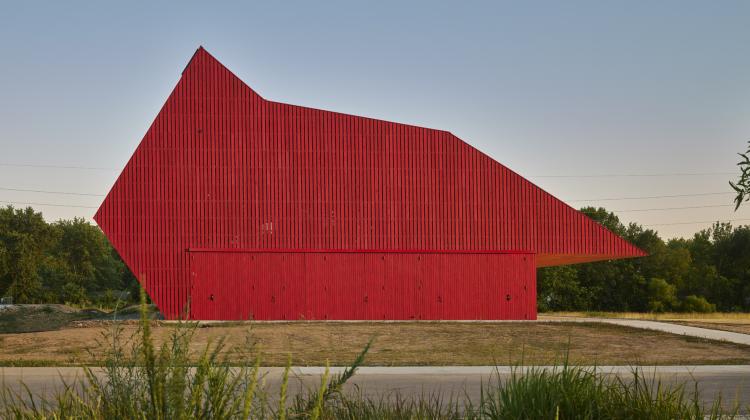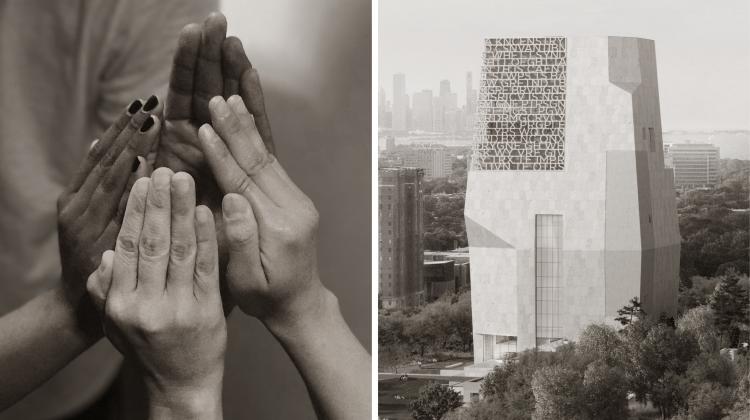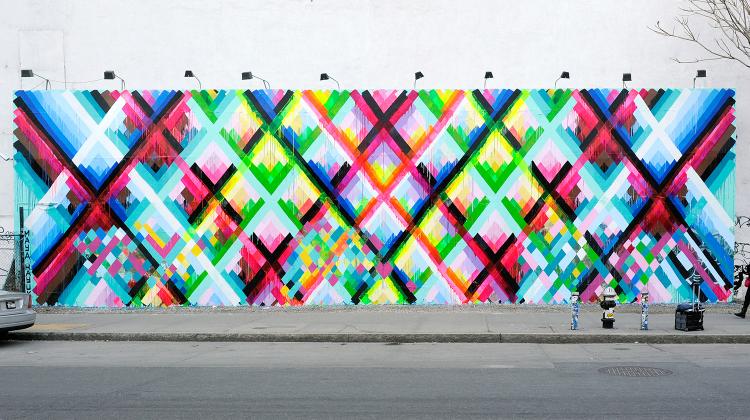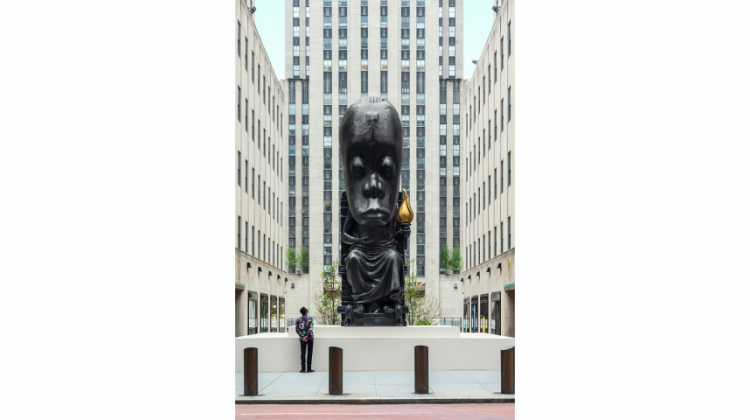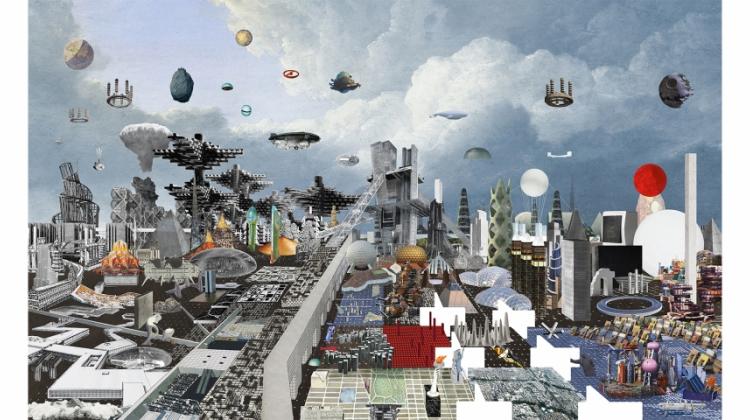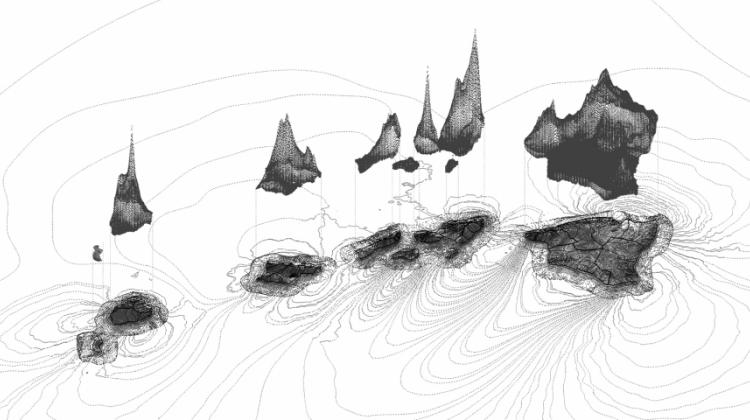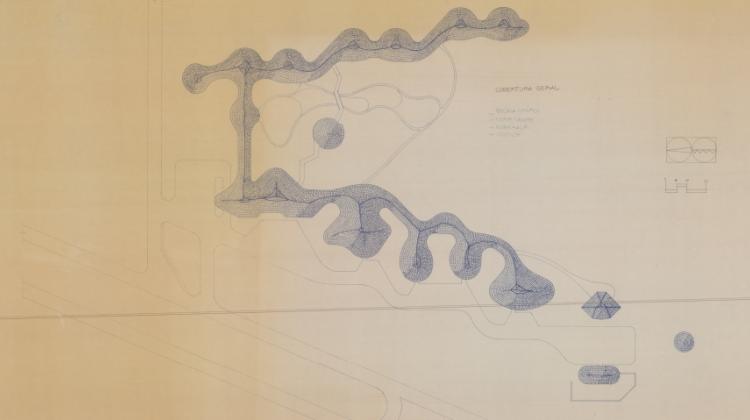Architecture + Urbanism
- Image
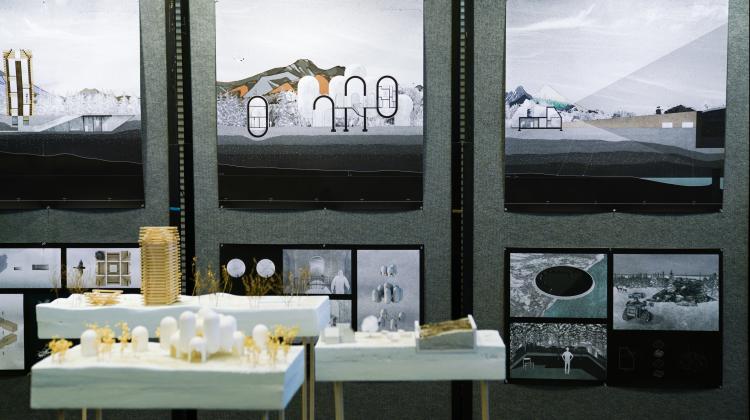
MArch Thesis- Fukushima Exclusion Zone Survival Handbook by Mengqiao Zhao
- Image

Core Studio I- Project by Carolyn Tam
- Image
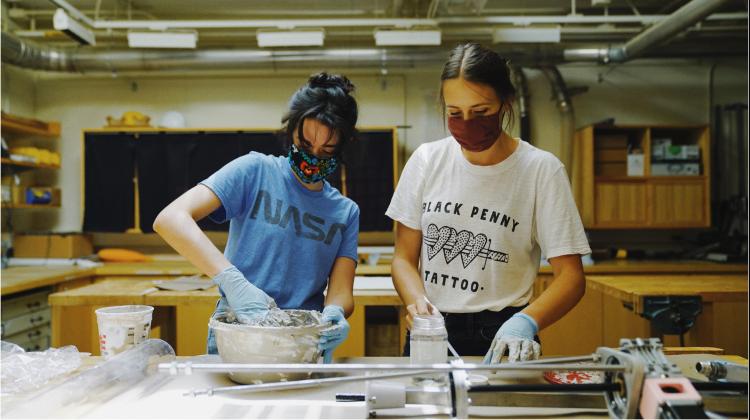
Students at work in the fabrication lab
- Image
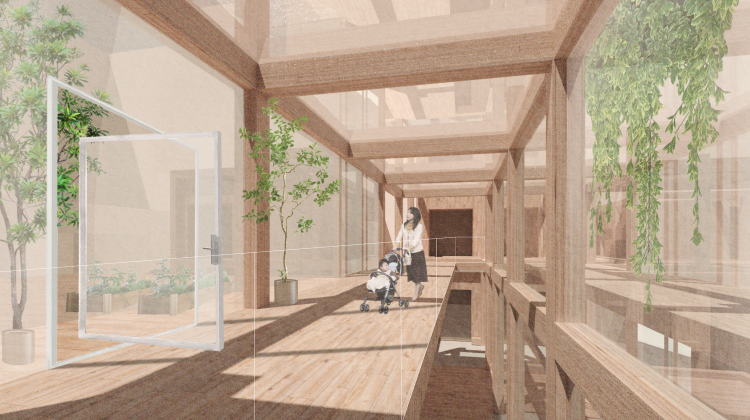
Core Studio II- Project by Bella Carmelita Carriker
- Image

Domo, Structures of Landscape, Tippet Rise Art Center, Fishtail, Montana- Ensamble Studio (Anton Garcia-Abril)
- Image

Core Studio III- Project by Lauren Gideonse and Calvin Zhong
- Image
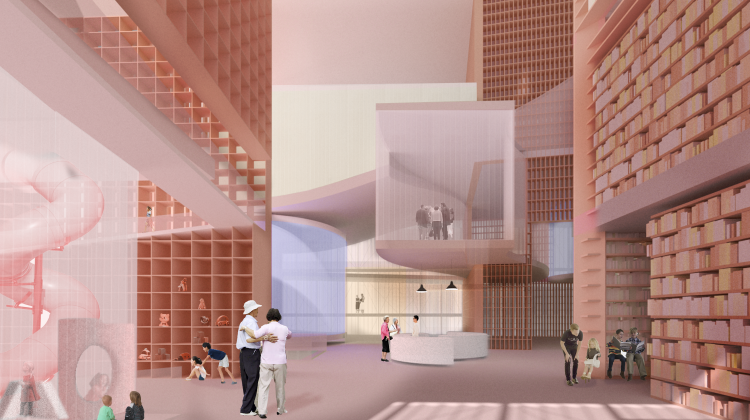
Core Studio II- Project by Inge Donovan
- Image

Option Studio: Making Ingredients- Project by Olivier Faber
- Image

Core Studio III- Projects by Tim Cousin, William Marshall, Natalie Pearl, Latifa Alkhayat
- Image
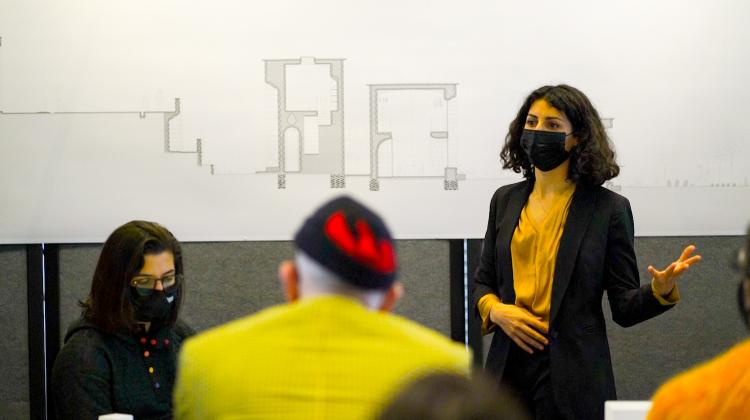
MArch Thesis Presentations
- Image
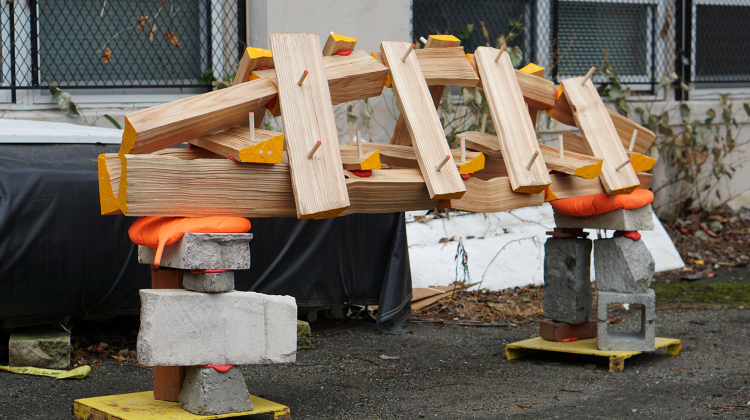
MArch Thesis- Medium Resolution by Gil Sunshine
- Image
Option Studio: Amazonia- Project by Carol-Anne Rodrigues
- Image
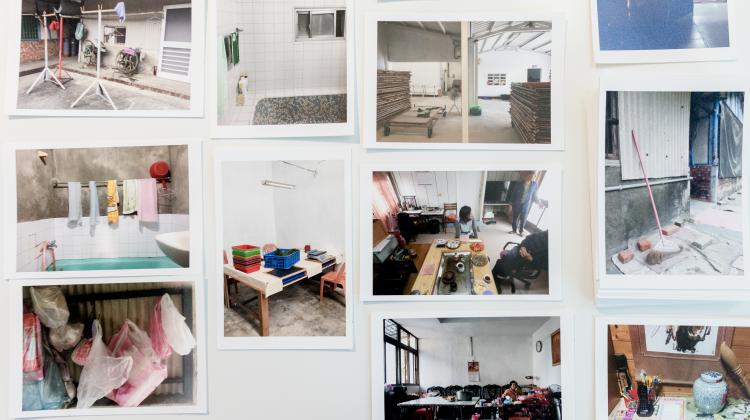
The past is in the present, Keller Gallery installation- Rosalyne Shieh
- Image
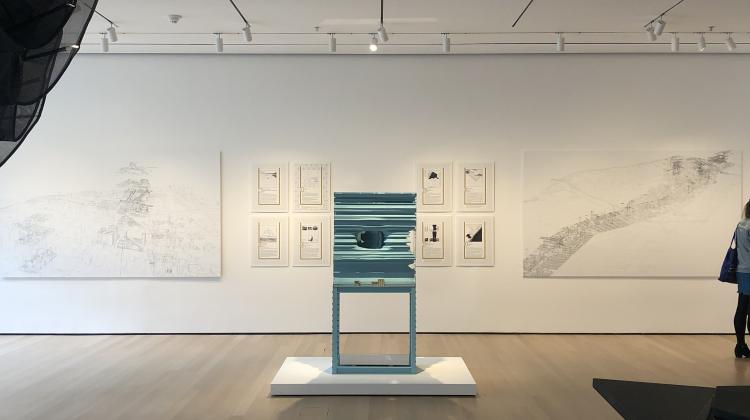
J. Yolande Daniels, Black City: The Los Angeles Edition. The Museum of Modern Art, 2021. Photo: Germane Barnes
- Image
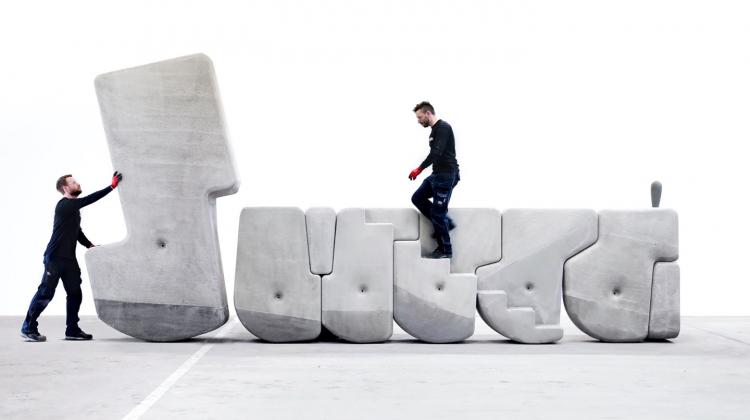
Walking Assembly- Brandon Clifford
- Image

Global Flora Greenhouse (Lafarge Holcim Award)- KVA Matx
- Image
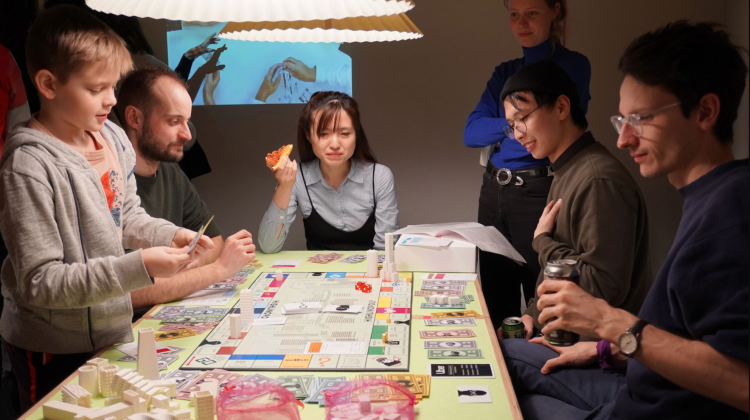
Play Room, Keller Gallery installation- Ana Miljački / Critical Broadcasting Lab
Contact
Eleni Aktypi
(M.Arch, SMArchS Architectural Design)
aktypi@mit.edu
Taariq Alasa
(M.Arch, SMArchS Urbanism)
talasa@mit.edu
Overview
With a group of active practitioners composing the core of the design faculty, Architecture + Urbanism at MIT is centered on contemporary practice. We actively pursue interdisciplinary collaboration, being keenly aware of the necessity to learn and borrow from, as well as to instigate exchange, with other disciplines. Yet we believe the foundational intelligence of architecture should be generated above all from the bottom up and within design itself.
Design today cannot afford not to address contemporary conditions such as climate change, globalization, technology and urbanization. As challenging as this may be, we are committed to investigating how these issues will inform and inspire design, as well as architectural education.
Architectural Design focuses on a broad range of perspectives linking several common concerns: site and context, use and form, building methods and materials, and the role of the architect. We see the architect less as the sole creator of an autonomous building than as a collaborator in shaping the physical environment.
Studios of increasing complexity form the core of the Architecture Design curriculum. Introductory studios, taught at both the undergraduate and graduate levels, provide a basic foundation and vocabulary for architectural design. For undergraduates, they help students decide whether they want to continue in architecture. Intermediate studios provide a range of experience of form-making, offering students the opportunity to learn from individual faculty members' particular approaches to exploring design issues. Advanced studios allow graduate students to sharpen their skills and develop their own approaches toward form-making. In their theses, students carry a project of their own from concept through theory and design to a final product.
Architectural Design offers a host of opportunities for students to engage and learn from faculty beyond the studio. Workshops, lectures, seminars, and research projects are just some of the ways that Architectural Design engages the built environment, the forces that mold it, and the design process itself. Our faculty undertake a wide variety of projects and research areas such as large-scale physical planning, behavioral studies, environmental programming, the form and evaluation of cities, computation and design, architectural theory and design methodology, decision making procedures in design, housing and settlement forms in developing countries, self-help processes, and design in non-Western cultures.
Students also have the opportunity to working with the Joint Program for City Design and Development, as well as the Center for Real Estate. Some students choose to follow a sequence leading to the Urban Design Certificate obtained with their degrees; others choose to extend their study period to seek dual degrees.
Architecture at MIT has a strong commitment to the urban contexts and challenges of design, from core studios to advanced option studios and design workshops in cities around the world. In addition, the Department offers a post-professional masters degree on Architecture+Urbanism. Architecture+Urbanism at MIT has three related meanings: 1) urban cultural change, 2) historical processes of urbanization, and 3) contemporary urban design. Design inquiry links them and is the principal means of advanced research in this field at MIT.
See Graduate Programs for degree requirements.
News
A+U Faculty + Staff
Hashim Sarkis
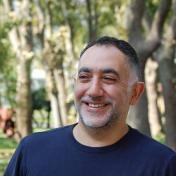 Professor; Dean, School of Architecture and Planning
Professor; Dean, School of Architecture and PlanningNicholas de Monchaux
 Department Head
Department HeadAna Miljacki
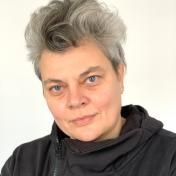 Professor, Director: SMArchS Programs and SMArchS AD Program
Professor, Director: SMArchS Programs and SMArchS AD ProgramWilliam O'Brien Jr.
 Associate Professor and M.Arch Program Director
Associate Professor and M.Arch Program DirectorSheila Kennedy
 Professor
ProfessorBrandon Clifford
 Associate Professor
Associate ProfessorMiho Mazereeuw
 Associate Professor, Associate Head for Strategy and Equity
Associate Professor, Associate Head for Strategy and EquityRafi Segal
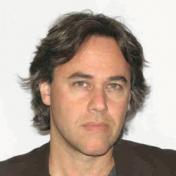 Associate Professor of Architecture and Urbanism, Department of Architecture
Associate Professor of Architecture and Urbanism, Department of ArchitectureAnton Garcia-Abril
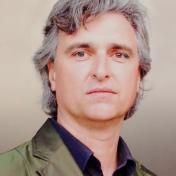 Professor
ProfessorCristina Parreño Alonso
 Senior Lecturer
Senior LecturerRania Ghosn
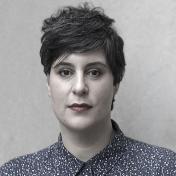 Associate Professor, Director of SMArchS Urbanism
Associate Professor, Director of SMArchS UrbanismYolande Daniels
 Associate Professor, Director, Architecture and Urbanism
Associate Professor, Director, Architecture and UrbanismXavi L. Aguirre
 Assistant Professor of Architecture
Assistant Professor of ArchitectureCarrie Norman
 Assistant Professor, Director of Undergraduate Major and Minor Programs
Assistant Professor, Director of Undergraduate Major and Minor ProgramsRosalyne Shieh
 Assistant Professor
Assistant ProfessorAngelo Bucci
 Professor of the Practice
Professor of the PracticeJ. Roc Jih
 Associate Professor of the Practice
Associate Professor of the PracticeMarcelo Coelho
 Lecturer
LecturerRoi Salgueiro Barrio
 Lecturer
LecturerJaffer Kolb
 Lecturer
LecturerAdam Modesitt
LecturerChristopher Dewart
 Technical Instructor
Technical InstructorJennifer OBrien
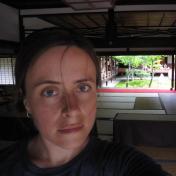 Technical Instructor / Shop Manager
Technical Instructor / Shop ManagerEleni Aktypi
 Discipline Group Assistant
Discipline Group AssistantTaariq Alasa
Area AssistantMark Goulthorpe
 Associate Professor
Associate ProfessorSkylar Tibbits
 Associate Professor, Director of Undergraduate Programs, Assistant Director for Education at the Morningside Academy for Design
Associate Professor, Director of Undergraduate Programs, Assistant Director for Education at the Morningside Academy for DesignJaffer Kolb
 Lecturer
LecturerAnne Whiston Spirn
 Cecil and Ida Green Distinguished Professor of Landscape Architecture and Planning Professor
Cecil and Ida Green Distinguished Professor of Landscape Architecture and Planning ProfessorGarnette Cadogan
 Tunney Lee Distinguished Lecturer in Urbanism
Tunney Lee Distinguished Lecturer in UrbanismRocio Crosetto Brizzio
 Belluschi Fellow
Belluschi FellowEkin Bilal
 Teaching Fellow
Teaching FellowAdriana Giorgis
 Teaching Fellow
Teaching FellowCalvin Zhong
 Teaching Fellow
Teaching FellowAnne Whiston Spirn
 Cecil and Ida Green Distinguished Professor of Landscape Architecture and Planning Professor
Cecil and Ida Green Distinguished Professor of Landscape Architecture and Planning ProfessorWilliam O'Brien Jr.
 Associate Professor and M.Arch Program Director
Associate Professor and M.Arch Program DirectorGarnette Cadogan
 Tunney Lee Distinguished Lecturer in Urbanism
Tunney Lee Distinguished Lecturer in UrbanismRocio Crosetto Brizzio
 Belluschi Fellow
Belluschi FellowEkin Bilal
 Teaching Fellow
Teaching FellowAdriana Giorgis
 Teaching Fellow
Teaching FellowCalvin Zhong
 Teaching Fellow
Teaching Fellow
SMArchS Design
The Master of Science in Architecture Studies (SMArchS) is a two-year program of advanced study founded on research and inquiry in architecture as a discipline and as a practice. The program is intended both for students who already have a professional degree in architecture and those interested in advanced non-professional graduate study.
The Design program offers both a theoretical foundation in the history and development of architectural design pedagogy and praxis and a platform for applied research into new design methodologies. To nurture independent theses related to the notion of design, the program aims to equip students with a critical understanding of different modes of creative synthetic production with particular focus on emerging modes of design activity, conceptual or technical, and on the potential for radicalizing current modes of architectural and building praxis.
The program encourages interdisciplinary engagement with other areas of specialist research within the Department and across the entire Institute, seeking to benefit from the remarkable academic and research environment of MIT. We see Design as a potentially integrative activity and support work that is collaborative or that bridges to other domains of knowledge.
The rich graduate design studios and workshops in the Architecture Department and Media Lab are open to SMArchS students, but the program intends to offer a distinctly post-graduate opportunity for individual design enquiry structured by seminars and lectures that give critical depth to such independent research work.
Events
SMArchS Urbanism
The Master of Science in Architecture Studies (SMArchS) in Urbanism is a two-year post-professional graduate program of advanced study for motivated and skilled individuals who wish to conduct rigorous design research on critical, complex urban issues facing the world today. The program is intended for students who already hold a professional degree in architecture, urban design, or landscape architecture and those interested in advanced non-professional graduate study.
SMArchS Urbanism is a design research program for the next generation of urbanists interested in the development of their own original research agenda and modes of design practice. With that objective in mind, SMArchS Urbanism approaches the urban question in an expanded framework. Students are invited to critically interrogate the field of urbanism—its definition, sites and scales, matters of concern, methods and media, and ultimately values. Beyond the conventional focus on city form, the program examines planetary processes as they impact land forms and life forms, always with an attention to specific places and situated worldviews. Pedagogically, this expanded framework invites the synthesis of knowledge and methods from related fields all while centering design inquiry to yield other more livable worlds.
The curriculum is structured to reinforce the design research pedagogy in urbanism, which culminates in a year-long thesis. The first year of the program provides a strong foundation with a required sequence of seminars on urban design research—its histories, theories and methods—and one studio that invites experimentation and speculation on how things might be otherwise. In the second year of the program, students complete a master’s thesis on an urban matter of concern and under the supervision of a faculty member. Students may participate in a joint studio with the Department of Urban Studies and Planning, enroll in one or more funded international workshops, and register in electives across the Institute.
The flexible curriculum empowers students to explore diverse research tracks and opportunities, taking advantage of the larger context of MIT and the School of Architecture and Planning – a remarkable academic and research environment with a culture of innovation, advocacy, and interdisciplinary knowledge creation. SMArchS Urbanism is intimately linked to the faculty-led labs and research centers that integrate many SMArchS students as researchers in ongoing investigations, and on diverse themes, such as ecological and climate change, infrastructure, geodesign, risk and equitable resilience, race, migration, energy systems, digital urbanism, transmedia storytelling, and future forms of living together, amongst others. SMArchS Urbanism also has strong historical ties and collaborations with the Department of Urban Studies and Planning, the largest urban planning faculty in the United States, and the Norman B. Leventhal Center for Advanced Urbanism, which focuses on the design and planning of large-scale, complex, metropolitan environments.
SMArchS Urbanism Students
SMArchS Urbanism Student Work
- Image

Between Birds and Humans - The Design of the Encounter - Thesis Project by Giovanni Belloti
- Image

Helena Rong - Berlin workshop by prof Segal
- Image

"Damp Skin The Porous Urbanity and Individual” Exhibit Curated by students Cheng-Hsin Chan (SMArchS ‘24), Ina Wu (MArch ‘25) & Zhi-Ray Wang (SMArchS ‘25)
- Image

FirstLaunched in 1987, the MIT-THU Urban Design Workshop occurred in partnership with Tsinghua University in 2024
- Image

Walls of Air, the Brazilian Pavilion at the 2018 Venice Architecture Biennale, co-curated by Gabriel Kozlowski
- Image

The Litani Basin in Lebanon_a metabolic conversion of politics into cancer by Mohamad Nahleh
- Image

A Kampung Ontology for the Global City by Sasha McKinley
- Image

“Exoercising A Haunted City” A Thesis project by Bryan Wong
- Image

Breaking Toxicity - Spatializing the Lethal in Microscopic Urbanism by Eakapob Huangthanapan
- Image

"Damp Skin The Porous Urbanity and Individual” Exhibit Curated by students Cheng-Hsin Chan (SMArchS ‘24), Ina Wu (MArch ‘25) & Zhi-Ray Wang (SMArchS ‘25)
- Image

Fields Beyond Home – Culture, Engineering and Development of Rice Farming by Namhi Kwun
MArch
As the first program of its kind in the United States, the professional degree program at MIT also has a particular responsibility to the future. Defined by the intersection of design and research, our professional program serves as a laboratory for all the innovation and scholarship within the department — while also serving as a laboratory for the future of architectural education itself.
In this laboratory, our students are leaders. The small size of MIT’s MArch program, with 25 students in each class, allows for unique trajectories through MIT, into the profession of architecture and beyond. The program’s size also ensures that our experiments together are conducted in an atmosphere of engaged debate—with ourselves, with guests, and with the larger communities which we serve. As well as within the classroom, this culture extends through public lectures and programs within the department, the School of Architecture and Planning and all of MIT, with students curating the most agile platforms for dialogue.
Though it feeds on everything that surrounds it, the MArch laboratory derives its energy from its key testing ground: the studio. Studio is a key site of iterative, embodied, design learning, where cultural meaning animates methods and materials with urgency. MIT’s MArch studio sequence is both surrounded by and infused with deep disciplinary and interdisciplinary thinking, sometimes in support of, and other times deliberately at odds with, studio concerns. It comprises three distinct units: (3) Core Studios, (3) Research Studios and a Thesis Project.
The collective mission of the three Core studios is to offer fundamental architectural methods to the students, while opening up a series of different entries into the vocation of an architect, such that students can begin to develop their own positions and become well versed at initiating other entries and paths through the discipline. Each of the Core studios is oriented toward the contemporary conversations and the future of the discipline. Which means that they are constantly updated. Though each of them delimits a different set of cultural, technical and disciplinary issues, together they deliver approaches, attitudes and questions that we deem essential for students who are establishing their own research projects and agenda.
For a large part of the population of every incoming class of MArch students, these three studios will be the first experiences in navigating uncertainty in the creative process, the exhilaration of giving form to ideas, imagining material assemblies with specific properties, and searching for the appropriate ways to align architecture’s agency with their own cultural and social ambitions. These will be experienced with increasing levels of control throughout our creative lives. Enabling a lifelong process of iteration and experimentation is the underlying ethos of all three core studios.
Following Core, the Research Studios offer an array of topics at scales that range from 1:1 experimentation in assembly to the geographic scale. They fit, though never neatly, into several categories of inquiry: architectural, which includes design of buildings and urban life; urban, which includes design of landscape, territories and the urban fabric); and cross studios, which focus on interdisciplinary topics and open up the possibilities for the final deliverables of the studio to take place in various media suited to the focus of their research.
Seminars and Lecture courses drill down into historical and disciplinary expertise, which contextualize, challenge and sometimes enable studio’s instrumental thinking, while Workshops provide a platform for faster, more discrete experimentation than is normally conducted in studios. All of these are mechanisms by which faculty involve students into the deep depths of their own research.
The Thesis semester caps the MArch studio sequence. It provides to students a precious and sustained space for their own experimentation with framing the terms of engagement with the world. The size of the program becomes relevant here once again. Many forms and formats of work are possible for this self-directed project; a student could choose to see their contribution at this stage as feeding into a larger project already well under way in the department, or one of the labs currently operating, or as a more intimate dialogue with individual faculty. The buzz, the energy, and the production that take place during the MArch thesis ferment into material artifacts, processes, statements—knowledge—that probes the edges of architecture. The final Thesis presentation, set to be the last event of the semester, is when the faculty involved in the MArch program together with students and guest critics celebrate our students’ ideas, risks taken, decisions made in the course of their thesis projects, and all those yet to come.













